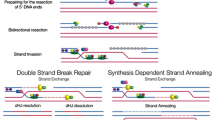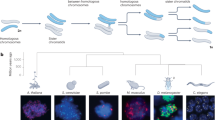Abstract
The selective forces responsible for the evolution of genes mediating recombination are discussed. These genes originated because of their role indna repair. In eukaryotes, their role in repair is not sufficient to account for the evolution of meiosis and syngamy. Therefore, a “hitch-hiking” explanation is required, according to which a recombination gene gets a lift in frequency from the high-fitness genes to which it is linked. Such hitch-hiking models are reviewed: collectively they provide an adequate explanation for the maintenance of sex and recombination in eukaryotes. In prokaryotes, the main selective force favouring recombination isdna repair: the cross-overs caused by recombination may occasionally have important evolutionary effects, but they are the consequences, rather than the causes, of the evolution of recombination in prokaryotes. In both prokaryotes and eukaryotes, recombination genes also cause specific, repeatable and adaptive rearrangements of the genetic material.
Similar content being viewed by others
References
Beli G 1982The masterpiece of nature: The evolution and genetics of sexuality (Berkeley: Univ. of California Press)
Bernstein H, Byerly H C, Hopf F A and Michod R E 1985Science 229: 1277–1281
Bernstein H, Hopf F A and Michod R E 1986Evolution (in press)
Charlesworth B 1976Genetics 83: 181–95
Charlesworth B 1978Proc. Nad. Acad. Sci. USA 75: 5618–22
Charlesworth B and Charlesworth D 1976Genet. Res. Camb. 25: 267–74
Eshel I and Feldman M W 1970Theor. Popul. Biol. 1: 88–100
Feldman M W, Christiansen F B and Brooks L D 1980Proc. Natl. Acad. Sci. USA 77: 4838–41
Felsenstein J 1985 inEvolution: Essays in honour of John Maynard Smith (eds) P J Greenwood, P H Harvey and M Slatkin (Cambridge: University Press) pp. 209–219
Felsenstein J and Yokoyama S 1976Genetics 83: 845–59
Fisher R A 1930The genetical theory of natural selection (Oxford: University Press)
Haigh J 1978Theor. Popul. Biol. 14: 251–67
Hamilton W D 1980Oikos 35: 282–90
Hannah-Alava A 1965Adv. Genet. 13: 157–226
Heller R and Maynard Smith J 1979Genet. Res. Camb. 32: 289–93
Jaenike J 1978Evol. Theory 3: 191–4
Kondrashov A S 1982Genet. Res. Camb. 40: 325–32
Maynard Smith J 1976J. Theor. Biol. 63: 245–58
Maynard Smith J 1978The evolution of sex (Cambridge: University Press)
Maynard Smith J 1980Genet. Res. Camb. 35: 269–77
Mukai T 1969Genetics 61: 749–61
Muller H J 1932Am. Nat. 66: 118–38
Muller H J 1964Mutat. Res. 1: 2–9
Selander R K and Whittam T S 1983 inEvolution of genes and proteins (eds) M Nei and R K Koehn (Sunderland, Mass: Sinauer) pp. 89–114
Strobeck C, Maynard Smith J and Charlesworth B 1976Genetics 82: 547–58
Sturtevant A H and Mather K 1938Am. Nat. 72: 447–52
Williams G C 1975Sex and evolution (Princeton: University Press)
Wright S 1931Genetics 16: 97–159
Author information
Authors and Affiliations
Rights and permissions
About this article
Cite this article
Smith, J.M. The evolution of recombination. J. Genet. 64, 159–171 (1985). https://doi.org/10.1007/BF02931144
Received:
Issue Date:
DOI: https://doi.org/10.1007/BF02931144




